Nativo Connector for MS Excel
Nativo Connector can be used to integrated operations supported by Nativo REST API.
In this article you will learn how to quickly and efficiently integrate Nativo data in MS Excel without coding. We will use high-performance Nativo Connector to easily connect to Nativo and then access the data inside MS Excel.
Let's follow the steps below to see how we can accomplish that!
Nativo Connector for MS Excel is based on ZappySys API Driver which is part of ODBC PowerPack. It is a collection of high-performance ODBC drivers that enable you to integrate data in SQL Server, SSIS, a programming language, or any other ODBC-compatible application. ODBC PowerPack supports various file formats, sources and destinations, including REST/SOAP API, SFTP/FTP, storage services, and plain files, to mention a few.
Create ODBC Data Source (DSN) based on ZappySys API Driver
Step-by-step instructions
To get data from Nativo using MS Excel we first need to create a DSN (Data Source) which will access data from Nativo. We will later be able to read data using MS Excel. Perform these steps:
-
Download and install ODBC PowerPack.
-
Open ODBC Data Sources (x64):

-
Create a User data source (User DSN) based on ZappySys API Driver
ZappySys API Driver
-
Create and use User DSN
if the client application is run under a User Account.
This is an ideal option
in design-time , when developing a solution, e.g. in Visual Studio 2019. Use it for both type of applications - 64-bit and 32-bit. -
Create and use System DSN
if the client application is launched under a System Account, e.g. as a Windows Service.
Usually, this is an ideal option to use
in a production environment . Use ODBC Data Source Administrator (32-bit), instead of 64-bit version, if Windows Service is a 32-bit application.
-
Create and use User DSN
if the client application is run under a User Account.
This is an ideal option
-
When the Configuration window appears give your data source a name if you haven't done that already, then select "Nativo" from the list of Popular Connectors. If "Nativo" is not present in the list, then click "Search Online" and download it. Then set the path to the location where you downloaded it. Finally, click Continue >> to proceed with configuring the DSN:
NativoDSNNativo
-
Now it's time to configure the Connection Manager. Select Authentication Type, e.g. Token Authentication. Then select API Base URL (in most cases, the default one is the right one). More info is available in the Authentication section.
Nativo authentication
Please refer to external API reference
API Connection Manager configuration
Just perform these simple steps to finish authentication configuration:
-
Set Authentication Type to
Http [Http] - Optional step. Modify API Base URL if needed (in most cases default will work).
- Fill in all the required parameters and set optional parameters if needed.
- Finally, hit OK button:
NativoDSNNativoHttp [Http]https://api.nativo.com/v2Optional Parameters Api Key Api Secret RetryMode RetryWhenStatusCodeMatch RetryStatusCodeList 429 RetryCountMax 5 RetryMultiplyWaitTime True 
-
Set Authentication Type to
-
Once the data source connection has been configured, it's time to configure the SQL query. Select the Preview tab and then click Query Builder button to configure the SQL query:
 ZappySys API Driver - NativoNativo Connector can be used to integrated operations supported by Nativo REST API.NativoDSN
ZappySys API Driver - NativoNativo Connector can be used to integrated operations supported by Nativo REST API.NativoDSN
-
Start by selecting the Table or Endpoint you are interested in and then configure the parameters. This will generate a query that we will use in MS Excel to retrieve data from Nativo. Hit OK button to use this query in the next step.
SELECT * FROM Orders Some parameters configured in this window will be passed to the Nativo API, e.g. filtering parameters. It means that filtering will be done on the server side (instead of the client side), enabling you to get only the meaningful data
Some parameters configured in this window will be passed to the Nativo API, e.g. filtering parameters. It means that filtering will be done on the server side (instead of the client side), enabling you to get only the meaningful datamuch faster . -
Now hit Preview Data button to preview the data using the generated SQL query. If you are satisfied with the result, use this query in MS Excel:
 ZappySys API Driver - NativoNativo Connector can be used to integrated operations supported by Nativo REST API.NativoDSN
ZappySys API Driver - NativoNativo Connector can be used to integrated operations supported by Nativo REST API.NativoDSNSELECT * FROM Orders You can also access data quickly from the tables dropdown by selecting <Select table>.A
You can also access data quickly from the tables dropdown by selecting <Select table>.AWHEREclause,LIMITkeyword will be performed on the client side, meaning that thewhole result set will be retrieved from the Nativo API first, and only then the filtering will be applied to the data. If possible, it is recommended to use parameters in Query Builder to filter the data on the server side (in Nativo servers). -
Click OK to finish creating the data source.
Video Tutorial
Read data in Excel from the DSN
-
In Excel click Data, then select Get Data, proceed with From Other Sources and choose From ODBC item. This will get data from ODBC data source we created:
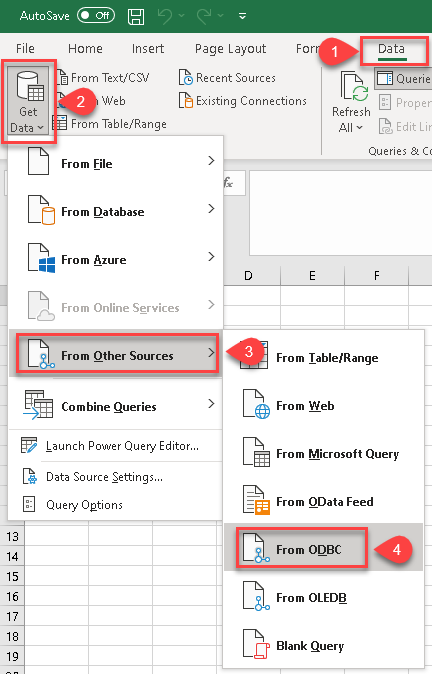
-
A small window opens, then simply select the data source you created in previous steps:
NativoDSN
-
Most likely, you will be asked to authenticate to a newly created DSN. Just select Windows authentication option together with Use my current credentials option:
NativoDSN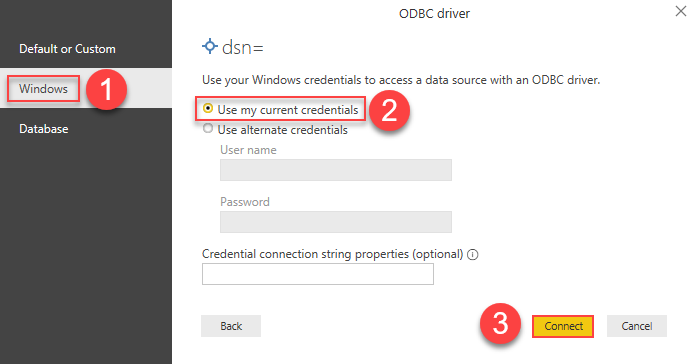
-
Finally, you will be asked to select a table or view to get data from. Select one and load the data!
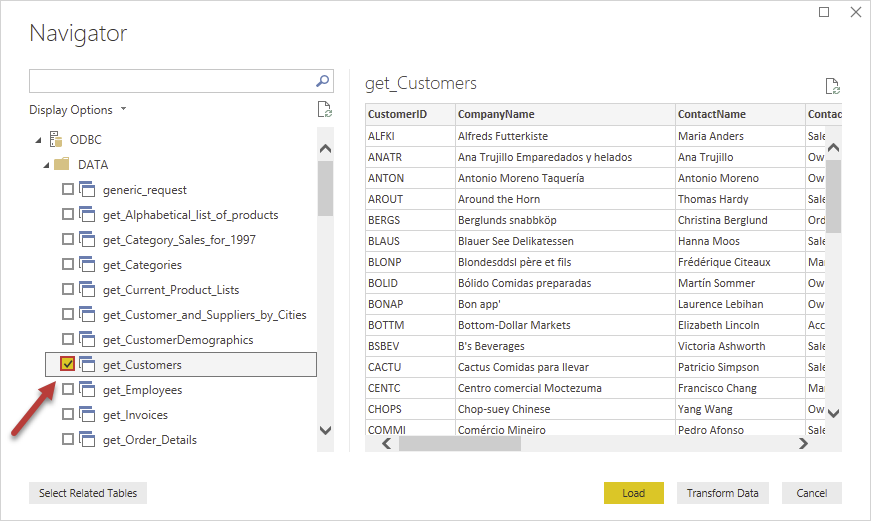
-
Finally, finally, use data extracted from Nativo API in an Excel worksheet:
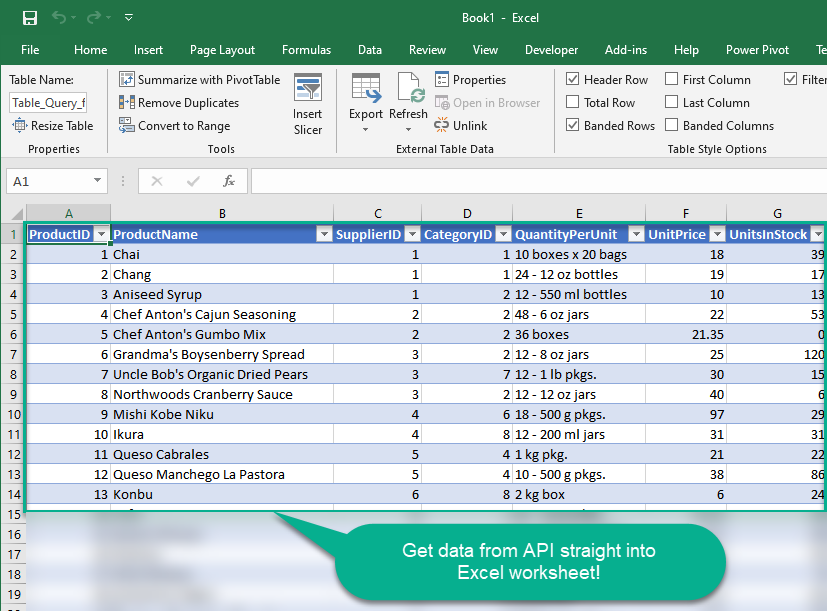
Refresh data source in Excel
When data updates in Nativo, it is not automatically refreshed in Excel. To update the worksheet, go to Data or Table Design tab and click the Refresh button:
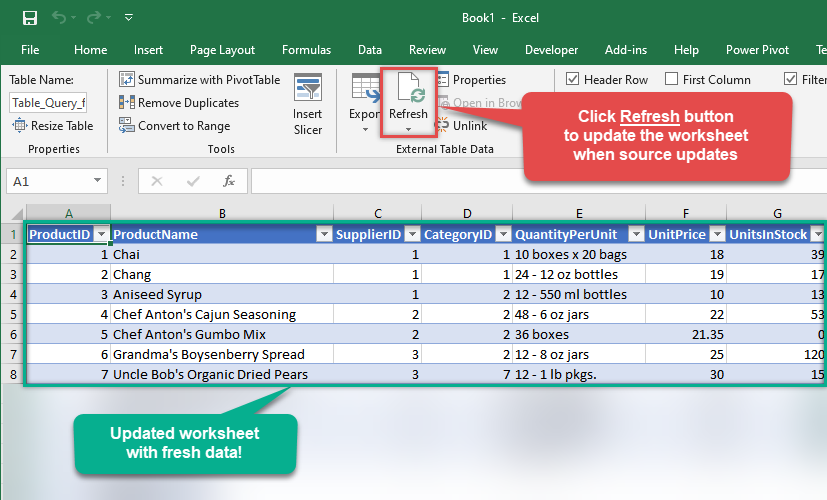
Actions supported by Nativo Connector
Learn how to perform common Nativo actions directly in MS Excel with these how-to guides:
- Read Advertisers Data
- Read Auction Campaign Data
- Read Campaign Data
- Read Demand Campaign Data
- Read DirectCampaign Data
- Read Inventory Campaign Data
- Read Managed Campaign Data
- Read Metrics
- Read Performance Campaign Data (Depriciated)
- Read Preferred Campaign Data
- Make Generic API Request
- Make Generic API Request (Bulk Write)
Conclusion
In this article we showed you how to connect to Nativo in MS Excel and integrate data without any coding, saving you time and effort.
We encourage you to download Nativo Connector for MS Excel and see how easy it is to use it for yourself or your team.
If you have any questions, feel free to contact ZappySys support team. You can also open a live chat immediately by clicking on the chat icon below.
Download Nativo Connector for MS Excel Documentation












































































